Hydroponics Grow Cubes: Your Essential Guide


Intro
Hydroponics is transforming agriculture by providing efficient ways to grow crops. Among the key components of hydroponic systems are grow cubes. These cubes play a vital role in supporting plant roots while facilitating nutrient absorption. Understanding their significance is essential for both new and experienced growers.
The relevance of hydroponics grow cubes extends beyond mere support. They are integral to optimizing growing conditions, enhancing yields, and promoting sustainability in agriculture.
In this guide, we will explore the diverse range of grow cubes, their composition, and their practical use cases in hydroponic systems. Having a clear grasp of these elements will empower practitioners to make informed choices in their agricultural endeavors.
Prelude to Hydroponics
Hydroponics presents a transformative approach to agriculture, allowing plants to grow without traditional soil. This method utilizes nutrient-rich water solutions and controlled environments to optimize growth conditions. In this article, we explore hydroponics grow cubes, which serve as a crucial component in hydroponic systems. These cubes provide stability for young plants while ensuring efficient nutrient and water uptake.
Definition and History
The term "hydroponics" comes from the Greek words for water (hydro) and labor (ponos). It refers to growing plants in a water-based, nutrient-rich solution. This cultivation technique dates back to ancient civilizations, such as the Hanging Gardens of Babylon and the floating gardens of the Aztecs. However, the modern understanding of hydroponics began in the 1930s when researchers explored soil-less cultivation systems. Learning about the relationships between plants and nutrients led to the development of various hydroponic systems we see today, including the effective use of grow cubes.
Importance in Modern Agriculture
The significance of hydroponics in modern agriculture cannot be overstated. As global populations increase, the demand for food rises correspondingly. Hydroponics allows for year-round cultivation, even in areas with limited arable land. Moreover, this method is water-efficient, using up to 90% less water than traditional farming practices. Hydroponics grow cubes contribute to the advantages mentioned, providing a consistent environment that supports plant growth.
"Hydroponics can enable the cultivation of crops in urban areas where space is limited, expanding agricultural possibilities where they were once thought impossible."
Implementing hydroponics, especially using grow cubes, is not only beneficial for increasing crop yield but also holds potential for sustainable farming practices. By reducing the need for pesticides and ensuring a more controlled growing environment, hydroponics offers a pathway to more environmentally friendly agricultural practices.
Understanding Grow Cubes
The section on understanding grow cubes is crucial for grasping their role in hydroponics. Grow cubes serve as the foundation for plant growth in a soilless environment. They facilitate the delivery of nutrients and water while providing necessary support for roots. The effectiveness of these cubes greatly influences the overall success of a hydroponic system. Recognizing the design, composition, and types of grow cubes helps growers choose the right options for their specific needs.
What are Grow Cubes?
Grow cubes are specially designed substrates used in hydroponic systems. They provide a stable base for seedlings and young plants. Unlike soil, which can harbor pests and diseases, grow cubes are typically sterile. This cleanliness promotes healthier plant growth. These cubes come in various shapes and sizes, tailored to support different types of plants. Their primary function is to provide both physical support and a moisture-retaining environment that allows roots to thrive.
Composition of Grow Cubes
The composition of grow cubes is fundamental in determining their performance in hydroponic systems. A wide range of materials can be utilized, each offering distinct advantages depending on grower goals and plant species.
Materials Used
Grow cubes are made from various materials, such as rockwool, coconut coir, peat, and expanded clay.
- Rockwool is a favorite due to its excellent insulation properties and water retention capabilities. It is inert and provides a stable environment for roots.
- Coconut coir is eco-friendly and sustainable. It has good water retention and drainage, fostering a beneficial growing environment.
- Peat is another common material, known for its nutrient-rich composition and moisture retention. However, its sustainability is often questioned due to peat mining's environmental impact.
- Expanded clay pebbles are lightweight and provide good drainage yet still retain sufficient moisture for plant roots.
Each material has unique features that can benefit different types of plants or systems. The right choice depends on various factors, including the specific hydroponic method in use and the plant species being cultivated.
Environmental Impact
The environmental impact of grow cubes is an essential consideration in today’s agricultural practices. The growing focus on sustainability highlights the need for eco-friendly materials.
- Rockwool, while effective, is not biodegradable and raises concerns about waste management after use. Some growers are shifting to more sustainable materials.
- Coconut coir tends to have a lower environmental footprint due to its renewable nature. However, sourcing must be managed to ensure it does not contribute to deforestation.
- Peat, while contributing beneficial properties to soil, is linked to carbon emissions when harvested unsustainably.
- Expanded clay pebbles are reusable but require energy-intensive manufacturing processes.
Understanding these environmental impacts allows growers to make better choices in cultivating sustainable practices, impacting the overall ecological footprint of hydroponic systems.
"Choosing the right grow cube is not just about plant growth; it is about sustainability and environmental responsibility."
Selecting appropriate grow cubes is vital for maximizing growth potential while minimizing negative effects on the environment. As hydroponics continues to evolve, so does the need for materials that not only support plant life but also protect our planet.
Types of Hydroponics Grow Cubes
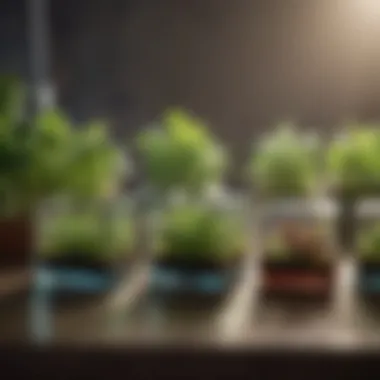
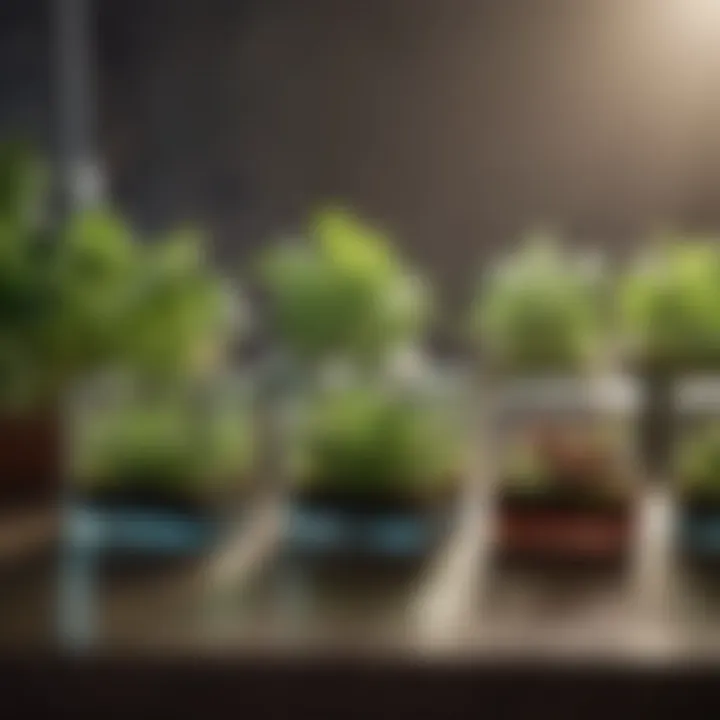
Understanding the different types of hydroponics grow cubes is vital for anyone engaging in this innovative method of agriculture. Each kind of cube offers unique benefits and considerations, making them suitable for various plant species and growth conditions. Selecting the right type can improve plant health, growth rate, and ultimately yield. Here, we will explore four primary types of grow cubes: Rockwool, Coconut Coir, Peat-Based, and Expanded Clay Pebbles.
Rockwool Cubes
Rockwool cubes are made from basalt rock. They undergo a heating and cooling process to create fibers. This material has excellent water retention properties while allowing good drainage and aeration.
- Advantages: They provide a consistent pH, which is beneficial for plant growth. Rockwool does not degrade quickly, ensuring durability in hydroponic applications.
- Considerations: It can be harmful if not handled properly due to its fibrous nature. Users should always wear a mask and gloves during handling to avoid skin and respiratory irritation.
Coconut Coir Cubes
Coconut coir cubes are derived from coconut husks. They are an environmentally friendly option, as this material is a waste byproduct from coconut production.
- Advantages: Coir cubes are biodegradable and effective for water retention, while also allowing good drainage. They offer an ideal growing medium for a variety of gardening applications.
- Considerations: Users should monitor nutrient levels carefully, as coir can leach some nutrients away when wet.
Peat-Based Cubes
Peat-based cubes are made from peat moss, which is harvested from peat bogs. These cubes provide a soft, moisture-retentive medium, useful for seedlings and young plants.
- Advantages: Peat is acidic and can help stabilize pH when growing certain plants. It also maintains moisture levels well, making it suitable for smaller, delicate plants.
- Considerations: The environmental impact of peat harvesting raises concerns. Its long-term sustainability is questionable, leading some growers to seek alternative options.
Expanded Clay Pebbles
Expanded clay pebbles, made from kiln-fired clay, are round balls that are lightweight and porous. These pebbles are commonly used in combination systems for their excellent drainage capabilities.
- Advantages: They are reusable, making them a cost-effective option in the long run. Expanded clay pebbles also help maintain stable temperatures around plant roots.
- Considerations: They do not retain as much moisture as other mediums, thus requiring more frequent watering or nutrient solutions to keep plants hydrated.
Understanding these different types of grow cubes enables growers to make informed decisions based on their specific needs and conditions. Choosing the right cube will directly affect the health and productivity of hydroponic systems.
Advantages of Using Grow Cubes
Hydroponics grow cubes offer several distinct advantages. These benefits are essential to understand for anyone interested in maximizing their yield and efficiency while reducing potential risks in hydroponic systems. Grow cubes provide a controlled environment for plant roots. This stability fosters healthy growth and can lead to quicker harvests. Below are key benefits that make grow cubes advantageous for growers.
Water Retention and Drainage
One of the primary benefits of using grow cubes is their ability to manage water effectively. Each cube's material determines how well it retains moisture and drains excess water. For instance, rockwool cubes are known for their excellent water retention, which helps keep the roots adequately hydrated. However, they also drain well, preventing the risk of root rot that comes with waterlogging.
Proper water management is critical in hydroponics. Growers can optimize the moisture levels. This balance leads to healthier plants and better yields. Moreover, sustainable water use is increasingly important in modern agriculture, and grow cubes assist significantly in this area by minimizing waste.
Effective moisture management leads to healthier plants and higher yields.
Nutrient Availability
Nutrient availability is another crucial element that grow cubes address effectively. They provide a stable medium for nutrient delivery to plant roots. Most grow cubes are designed to hold nutrients within their structure. This attribute helps keep the essential minerals and vitamins easily accessible to the plants during their growth.
Different types of cubes offer various nutrient retention properties. For example, coconut coir cubes release nutrients slowly, allowing for longer intervals between re-filling nutrient solutions. This slow-release feature can simplify nutrient management over time, easing the burden on growers. The predictability of nutrient availability leads to consistent growth and healthier crops.
Space Efficiency
Space efficiency cannot be overlooked when discussing the advantages of grow cubes. These cubes occupy less space than traditional soil pots. This compact size allows growers to maximize their growing area, increasing potential output in limited space.
In high-density systems, such as vertical farming, grow cubes can stack or arrange in layers without compromising plant health or access to light. This configuration is especially useful in urban agriculture and small-scale growing operations. Utilizing space efficiently enables urban farmers and hobbyists to cultivate a wider array of plants, contributing to diverse harvests even in confined areas.
In summary, grow cubes present notable advantages that enhance hydroponic gardening. From effective water management to improved nutrient delivery and maximum space utilization, they contribute significantly to more productive and sustainable agriculture.
Challenges When Using Grow Cubes
While hydroponics grow cubes have significant benefits, they also present certain challenges. Understanding these can help practitioners navigate potential pitfalls and improve their overall experience. Recognizing the limitations and issues tied to using grow cubes is crucial for both novice and experienced growers.
Risk of Overwatering
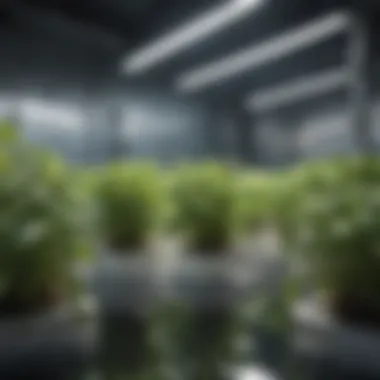
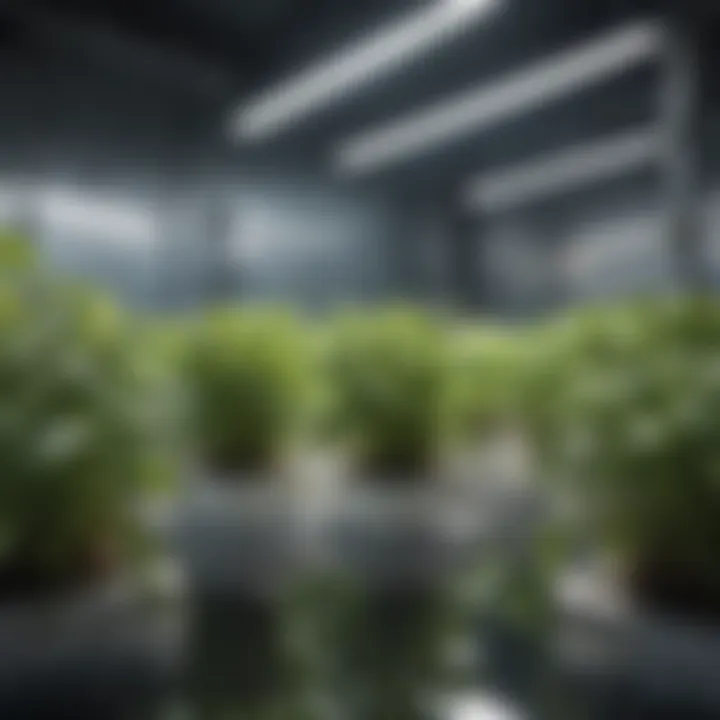
One of the primary challenges faced with grow cubes is the risk of overwatering. Hydroponic systems require careful monitoring of moisture levels. When grow cubes retain too much water, it can lead to root rot and other detrimental conditions for the plants.
Overwatering often occurs when growers misjudge the frequency and duration of irrigation cycles. This can happen for various reasons, including variability in cube material or environmental factors such as humidity and temperature. It is essential for growers to understand the specific needs of their plants and adjust water application accordingly.
To mitigate this risk, it is recommended to:
- Monitor moisture levels regularly.
- Use sensors that can provide real-time data on the moisture content in grow cubes.
- Adjust the irrigation schedule based on the growth stage of the plants.
pH and EC Management
Managing pH and electrical conductivity (EC) in hydroponic systems is another task that can pose challenges when using grow cubes. The effectiveness of nutrient uptake by plants heavily relies on these factors. The ideal pH level for most plants in hydroponics lies between 5.5 and 6.5.
Grow cubes can sometimes alter the pH level due to their composition. For instance, different materials like Rockwool or coconut coir may have varying impacts on the overall pH. Changes in pH can hinder nutrient absorption. Consequently, growers need to regularly test and adjust pH levels to maintain optimal conditions.
Furthermore, electrical conductivity also needs monitoring to ensure that nutrient concentrations are within the recommended range. An EC that is too high can cause nutrient burn, while one that is too low can lead to nutrient deficiencies. To successfully manage these factors, it is advisable to:
- Regularly test pH and EC using reliable meters.
- Keep a log to track changes and adjust accordingly.
- Implement solutions to buffer pH when necessary.
Cost Considerations
Cost is often a significant factor when it comes to adopting new technologies or materials, including grow cubes. Initially, investing in hydroponic systems might seem expensive due to the price of grow cubes and the accompanying equipment needed.
However, selecting the right type of grow cube can help optimize costs over time. Different materials come at various price points, and while some may be more expensive upfront, they might offer better durability, efficiency, and reusability in the long run. This makes careful selection a necessary consideration.
Growers should also account for the cost of maintenance and any additional resources required for effective management of grow cubes—such as monitoring equipment and pH solutions. Therefore, evaluating the total cost over time rather than only initial expenses will lead to a more informed decision.
Best Practices for Using Grow Cubes
Understanding and applying best practices for using grow cubes is essential for achieving optimal results in hydroponic systems. These practices ensure that the cubes function effectively while promoting healthy plant growth. Each phase from preparation to monitoring contributes to the overall success of utilizing grow cubes in hydroponics.
Preparation and Installation
Preparation begins with selecting the right type of grow cube. The choice of grow cube can influence the growth phase of your plants significantly. Different cubes have varying strengths, such as water retention or aeration properties. After selection, proper installation of the cubes is crucial. Here are key steps to follow:
- Soak the Cubes: Before planting, soak the grow cubes in water mixed with nutrients. This allows for proper absorption and helps in establishing a nutrient-rich environment for the plants.
- Proper Drainage: Ensure that the installation area provides adequate drainage. Overloaded water can lead to root rot, so setting the cubes on a surface that allows excess water to escape is necessary.
- Planting Depth: When planting, take into account the required depth for the specific crop. Each plant type has different root needs, so follow their guidelines closely.
- Spacing: Provide enough spacing for each cube, allowing roots to expand and minimizing competition for nutrients. A well-planned layout can significantly increase overall yield.
Following these steps during the preparation phase will greatly enhance the suitability of grow cubes for your plants.
Monitoring Plant Health
Constant monitoring of plant health is vital in the hydroponic process using grow cubes. This ensures that any issues are caught early, preventing potential failures. Here are some critical aspects to focus on:
- Visual Inspections: Regularly check the plants for signs of stress or diseases, such as yellowing leaves or wilting. Early detection can save crops.
- Environmental Checks: Monitoring temperature and humidity is important. Hydroponic plants need specific conditions for optimal growth. Ensure they are within the ideal range for the species you are cultivating.
- pH Levels: Maintaining appropriate pH levels in the nutrient solution is crucial. It impacts nutrient availability. Regularly test and adjust the pH as necessary to keep it within the optimum range of 5.5 to 6.5.
- Nutrient Profiles: Monitoring the concentration of nutrients in the water is vital. Plants have distinct nutrient needs, and providing a balanced solution will maximize growth rates.
By employing these monitoring strategies, growers can maintain healthy plants and optimize the performance of grow cubes in hydroponic systems.
"Effective monitoring can be critical to achieving bountiful yields in hydroponic systems. Ignoring plant health signs places the entire growth cycle at risk."
In summary, best practices for using grow cubes involve thorough preparation and diligent monitoring. By adhering to these strategies, growers can enhance their hydroponic cultivation, resulting in healthier plants and improved yields.
Applications in Various Hydroponic Systems
The use of hydroponics grow cubes is pivotal in modern agricultural practices. Their ability to provide a stable medium for plant roots enhances growth efficiency and optimizes management of resources like water and nutrients. Understanding how these cubes function across different hydroponic systems is essential for both novice and experienced growers. Each hydroponic method has unique characteristics, yet they all can benefit from the versatility of grow cubes.
Nutrient Film Technique (NFT)
The Nutrient Film Technique is a method where a thin film of nutrient solution circulates over the roots of the plants. Grow cubes are often used in NFT to anchor the plants securely while allowing free access to the nutrient film. This system minimizes water usage, making it highly efficient.
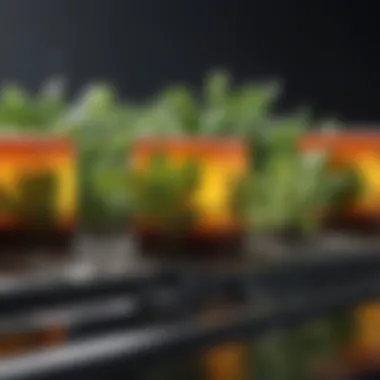

Benefits of NFT with Grow Cubes:
- Water Efficiency: Minimal water is needed as it continuously circulates.
- Nutrient Accessibility: Plants have constant access to nutrients.
- Easy Monitoring: Growth and health status can be easily observed.
Deep Water Culture (DWC)
In the Deep Water Culture system, plant roots are submerged in nutrient-rich water. Grow cubes act as support structures, keeping plants above water while allowing their roots to reach into nutrient solution. This method facilitates rapid growth due to oxygen-enriched water.
Considerations for DWC with Grow Cubes:
- Oxygenation: Regularly aerating the water is crucial to prevent root rot.
- Temperature Control: Maintaining water temperature is important for health.
- Light Exposure: Ensure that light does not hinder root growth.
Ebb and Flow Systems
Ebb and Flow systems alternate between flooding and draining the grow area. This cycle allows plants to receive nutrients and oxygen. Grow cubes can be arranged in trays, ensuring that every plant receives the right amount of water and nutrients during the flooding phase.
Advantages of Ebb and Flow with Grow Cubes:
- Versatile Planting: Suitable for various plant types.
- Easy Drainage: Reduces the risk of overwatering.
- Nutrient Distribution: Evenly distributes nutrients to all cubes when flooded.
Using grow cubes across diverse hydroponic systems enhances crop yield and may lead to more sustainable agricultural practices.
In summary, the integration of hydroponics grow cubes in different hydroponic systems such as NFT, DWC, and Ebb and Flow emphasizes their versatility and essential role in modern hydroponics. Each system brings unique challenges but also significant benefits when utilizing grow cubes effectively.
Future Trends in Hydroponics Grow Cubes
The future of hydroponics grow cubes is a reflection of advancements in both technology and environmental awareness. Grow cubes play an essential role in modern horticulture. They offer a substrate that supports plant growth while ensuring efficient nutrient delivery. As the demand for sustainable farming practices rises, understanding future trends becomes key for farmers and enthusiasts. New materials and techniques can significantly affect yield, cost, and environmental impact.
Innovations in Material Science
Material science drives innovation in grow cubes. Traditionally, materials such as Rockwool and peat were popular, but new types are emerging. Researchers are exploring biodegradable options. Also, hydrogels are gaining attention. These materials retain water efficiently, providing stable conditions for roots.
"The next generation of grow cubes can transform not only how we grow but how we think about sustainable agriculture."
These innovations bring multiple benefits:
- Enhanced Water Retention: New materials can hold moisture longer, reducing the need for frequent watering.
- Reduced Environmental Footprint: Biodegradable and renewable materials lessen waste and promote ecological balance.
- Improved Nutrient Release: Advanced materials allow for controlled nutrient delivery, ensuring plants get what they need.
Sustainability Efforts
Sustainability remains a focal point in the development of hydroponics grow cubes. As awareness of environmental issues grows, focus shifts to methods that limit resource use. Sustainable practices in hydroponics can significantly minimize the carbon footprint. Efforts include:
- Recycling Materials: Organizations are beginning to explore using recycled plastics for grow cube production.
- Life Cycle Analysis: Understanding the entire life cycle of grow cubes helps in minimizing waste and assessing their overall impact on the environment.
- Organic Options: There is an increased demand for organic growing media that align with sustainable farming practices.
Furthermore, integrating renewable energy sources in production processes is essential. This paves the way for a greener approach to horticulture. Farmers integrating these sustainable trends can expect not only ecological benefits but also potentially higher market values for their yield.
End
In this article, we explored the multifaceted world of hydroponics grow cubes. Their significance extends far beyond mere planting tools; these cubes represent an evolution in agricultural methods, addressing a variety of contemporary issues in food production. The efficient use of space, water conservation, and enhanced nutrient delivery are just a few benefits they provide. Each type of grow cube, from Rockwool to coconut coir, offers unique properties that cater to different cultivation needs.
Summary of Key Points
The primary takeaways from our discussion include the following:
- Diverse Materials: Grow cubes come in a variety of materials, such as Rockwool, coconut coir, and peat-based options. Each has distinct environmental impacts and cultivation benefits.
- Optimal Growing Conditions: Proper management of pH and moisture is crucial to avoid problems like overwatering, ensuring that plants achieve maximum growth potential.
- Best Practices: Successful hydroponic cultivation requires thorough preparation, continuous monitoring of plant health, and adherence to standard practices to optimize results.
- Future Trends: The ongoing innovations in material science and sustainability efforts indicate that the landscape of hydroponics will continue to evolve.
The Future of Hydroponics
Looking ahead, the future of hydroponics and grow cubes appears promising. With advancements in technology, solutions for the pressing demands of food security appear to be on the horizon. As urbanization increases and climate change challenges conventional agriculture, hydroponics offers viable alternatives.
Efforts towards sustainability are on the rise. Focusing on minimizing environmental footprints while maximizing productivity remains a priority for researchers and farmers alike. Innovations, such as biodegradable grow cubes, may very well change the game, aligning with global sustainability goals.
"Hydroponics is not just a method of growing plants; it is a pathway to a sustainable future in agriculture."
As we continue to explore the intersections of technology, sustainability, and agriculture, it is vital that practitioners stay informed and engaged with evolving trends. This will not only enhance their practices but also contribute positively to the broader agricultural community.



